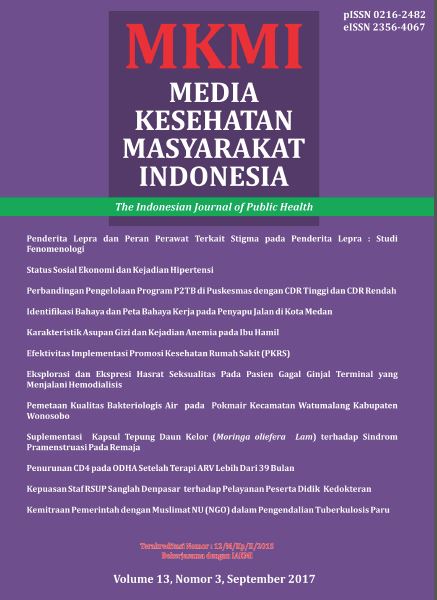PERBANDINGAN PENGELOLAAN PROGRAM P2TB DI PUSKESMAS DENGAN CDR TINGGI DAN CDR RENDAH
Abstract
Salah satu permasalahan dalam program penanggulanan tuberculosis (TB) adalah rendahnya cakupan penemuan kasus TB paru di puskesmas, serta bervariasinya angka pencapaian Case Detection Rate (CDR). Penelitian ini bertujuan membandingkan pengelolaan Program P2TB di dua puskesmas kecamatan dengan pencapaian CDR TB tinggi dan rendah di wilayah Jakarta Timur. Metode penelitian adalah kualitatif yang diperkuat data kuantitatif faktor individu dan sosial dengan pendekatan cross sectional. Hasil penelitian menunjukkan adanya perbedaan dalam manajemen yang mana puskesmas dengan CDR TB tinggi mempunyai Kepala Puskesmas dengan kemampuan manajerial Program P2TB yang baik, mekanisme transfer of knowledge yang baik (komponen input); perencanaan target berbasis masalah untuk meningkatkan CDR TB, program penjaringan kasus secara aktif dengan melibatkan kader dan lintas sektor, adanya antisipasi hasil mutu laboratorium serta monitoring dan evaluasi yang baik (komponen proses); dan memenuhi seluruh target indikator penemuan penderita TB (komponen output). Hasil tersebut diperkuat faktor individu (pengetahuan, sikap suspek terhadap bahaya dan cara pencegahan, serta persepsi suspek terhadap pelayanan kesehatan) dan faktor sosial (dukungan kader, KIE oleh petugas) lebih baik pada puskesmas dengan CDR TB tinggi. Dapat disimpulkan bahwa untuk meningkatan CDR, diperlukan pelatihan TB kepada top manajemen, penjaringan kasus aktif dengan melibatkan kader dan sektor non kesehatan, serta kerjasama lintas sektor.
Full text article
References
Eugene Braunwald, et.al. Mycobacterial Disease: Tuberculosis. Harrisson‟s: Principle of Internal Medicine 17th ed. New York: McGraw-Hill Companies; 2009.
World Health Organization. WHO Report 2013-Global Tuberculosis Control. Available on www.who.int/tb/ data. Diunduh tanggal 10 September 2014.
Badan Penelitian dan Pengembangan Kesehatan. Pokok-pokok Hasil Riskesdas Indonesia 2013. Jakarta: Kementerian Kesehatan RI; 2014.
Kementrian Kesehatan RI. Pedoman Nasional Penanggulangan Tuberkulosis. Jakarta : Departemen Kesehatan Republik Indonesia; 2014.
World Health Organization (WHO). Tuberkulosis Case Detection, Treatment and Monitoring. 2nd ed. Geneva: World Health Organization. 2004.
Suku Dinas Kesehatan Kota Administrasi Jakarta Timur. Laporan Tahunan Program TB Tahun 2014; Seksi PM Kes. 2015.
Shargie,et.al., Tuberculosis Case Finding
in Southern Ethiopia.Bulletin of the World Health Organization. 2006;84(2).
Reviono, E Sulaeman, B Murti, Modal Sosial dan Partisipasi Masyarakat dalam Penemuan Penderita TB. Jurnal Kesehatan Masyarakat Nasional. 2013;7(11).
Ida Leida LK. Efek Promosi Kesehatan pada Kelompok Masyarakat Informal dalam Mendeteksi Supek TB di Kabupaten Gowa tahun 2007. Kumpulan Riset Operasional Tuberkulosis Tahun 2005-2009. Pokja Riset Operasional Tuberkulosis, Ditjen PP dan PL, Kementrian Kesehatan Republik Indonesia; 2009.
Notoatmodjo S. Promosi Kesehatan dan Perilaku Kesehatan, Jakarta: Rineka Cipta; 2012.
Awusi RYE, dkk, Faktor-Faktor yang Mempengaruhi Penemuan Penderita TB Paru di Kota Palu Sulawesi Tengah. Berita Kedokteran Masyarakat. 2009;25(2).
Seddig K et.al. Implementing a Succesfull Tuberculosis Programme Within Primary Care Service in a Conflic Area using the Stop TB Strategy: Afghanistan Case Study. 2011.
Mupere,Effectiveness of Active Case Finding Strategies in Tuberculosis Control in Kampala Uganda. The International Journal of Lung and Tuberculosis. 2013;7(2).
P. Ginanjar, L Saraswati, E. D. Astuti. Suspect Detection and Active Case Finding are Important in Increase Case Detection Rate (CDR). 2013.
Alexei Korobitsyn, et. al., TB Case Detection in Tajikistan: Analysis of Existing Obstacles Central. Asian Journal Of Global Health. 2013;2(2).
Sri Ratna Rahayu, et. al., Factors Associated with Tuberculosis Cases in Semarang District, Indonesia: Case–Control Study Performed in the Area where Case Detection Rate was Extremely Low Environmental Health Preventive Medicine. 2015;20:253–261.
Anna H. van’t Hoog, et. al., Risk Factors for Inadequate TB Case Finding in Rural Western Kenya: A Comparison of Actively and Passively Identified TB Patients. www.plosone. org, April 2013;(8):4.
Authors
Authors retain copyright and grant the journal right of first publication with the work simultaneously licensed under a Creative Commons Atribusi-NonKomersial-BerbagiSerupa 4.0 Internasional License that allows others to share the work with an acknowledgement of the work's authorship and initial publication in this journal.
Copyright encompasses rights to reproduce and deliver the article in all form and media, including reprints, photographs, microfilms and any other similar reproductions, as well as translations. The reproduction of any part of this journal, its storage in databases and its transmission by any form or media, such as electronic, electrostatic and mechanical copies, photocopies, recordings, magnetic media, etc.
All articles published Open Access are free for everyone to read and download. Under the CC-BY-NC-SA license, authors retain ownership of the copyright for their article, but authors grant others permission to use the content of publications in Media Kesehatan Masyarakat Indonesia Universitas Hasanuddin in whole or in part provided that the original work is properly cited. Users (redistributors) of Media Kesehatan Masyarakat Indonesia Universitas Hasanuddin are required to cite the original source, including the author's names, Media Kesehatan Masyarakat Indonesia Universitas Hasanuddin as the initial source of publication, year of publication, and volume number.
Media Kesehatan Masyarakat Indonesia Universitas Hasanuddin is licensed under Creative Commons Atribusi-NonKomersial-BerbagiSerupa 4.0 Internasional.


